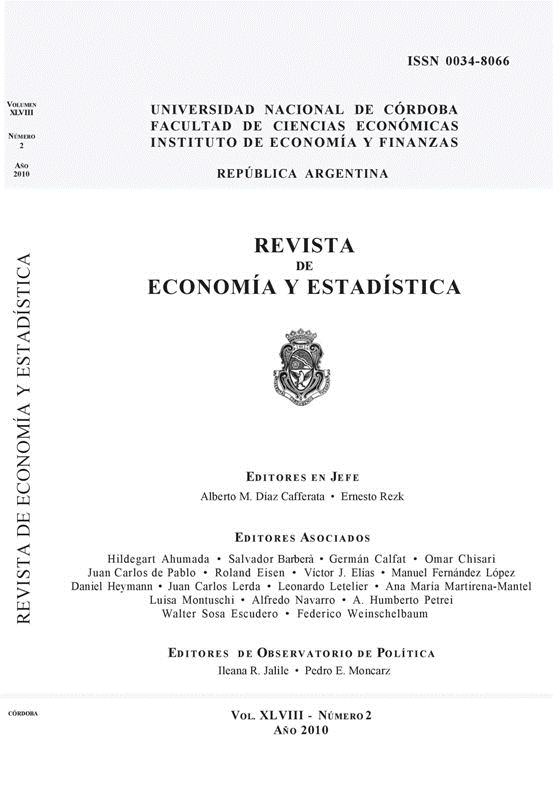Multiplicadores fiscales en la zona euro
DOI:
https://doi.org/10.55444/2451.7321.2010.v48.n2.4105Palabras clave:
área euro, SVAR, shocks fiscales, multiplicadores fiscalesResumen
Por medio de un modelo VAR estructural lineal estándar, se analiza lamagnitud y el signo de los multiplicadores fiscales para la zona euro,utilizando una base de datos trimestrales de variables fiscales para el período1981-2007 recientemente disponible. Desde una perspectiva política, elanálisis de los multiplicadores fiscales en "tiempos normales" proporcionainformación detallada sobre el impacto tanto de medidas de estímulo fiscal ymedidas de consolidación fiscal, a condición de que los períodos "buenos" y"malos" sean en promedio similares.
Descargas
Citas
Afonso, A. and R. M. Sousa (2009a). “The macroeconomic effects of fiscal policy”. ECB Working Paper Series No. 991, January.
Afonso, A. and R. M. Sousa (2009b). “The macroeconomic effects of fiscal policy in Portugal: a Bayesian SVAR analysis”. School of Economics and Management, Working Papers Nº 09/2009/DE/UECE.
Bénassy-Quéré, A. and J. Cimadomo (2006). “Changing patterns of domestic and cross-border fiscal policy multipliers in Europe and the US”. CEPII WP #2006-24.
Beetsma, R. and M. Giuliodori (2009). “Discretionary fiscal policy: review and estimates for the EU”. Mimeo.
Blanchard, O. J. and R. Perotti (2002). “An Empirical Characterization of the Dynamic Effects of Changes in Government Spending and Taxes on Output”. Quarterly Journal of Economics, 117, pp. 1329-1368.
Bouthevillain, C., Cour-Thimann, P., van den Dool, G., Hernández de Cos, P., Langenus, G., Mohr, M., Momigliano, S., Tujula, M., 2001. “Cyclically adjusted budget balances: An alternative approach”. ECB Working Paper Series No. 77.
Burriel, P., de Castro, F., Garrote, D., Gordo, E., Paredes, J., Pérez, J., 2010. “Fiscal Policy shocks in the Euro Area and the US: an empirical assessment”, Fiscal Studies, 31(2), pp. 251-285.
Caldara, D. and C. Kamps (2008). “What are the effects of fiscal policy shocks? A VAR-based comparative analysis”. ECB Working Paper Series No. 877, March.
Cogan, J., T. Cwik, J.B. Taylor and V. Wieland (2009). “New Keynesian versus Old Keynesian Government Spending Multipliers”. CEPR Discussion Paper 7236, March.
Christoffel, K., G. Coenen and A. Warne (2008). “The New Area-Wide Model of the euro area: a micro-founded open-economy model for forecasting and policy analysis”. ECB Working Paper Series No 944, October.
Cwik, T. and V. Wieland, (2009). “Keynesian government spending multipliers and spillovers in the Eurozone”. CEPR Discussion Paper 7389, August.
de Castro, F. (2006). “The macroeconomic effects of fiscal policy in Spain”. Applied Economics, 38, pp. 913-924.
de Castro, F and P. Hernández de Cos (2008). “The economic effects of fiscal policy: the case of Spain. Journal of Macroeconomics”, 30, pp. 1005-1028.
Fatás, A. and I. Mihov (2001). “The effects of fiscal policy on consumption and employment: theory and evidence”. CEPR Discussion Paper Series No. 2760.
Fagan, G., J. Henry and R. Mestre (2005). “An area-wide model (AWM) for the euro area. Economic Modelling”, 22, pp. 39-59.
Favero, C, and F. Giavazzi (2007). “Debt and the effects of fiscal policies”. NBER Working Paper Series No. 12822.
Giordano, R., S. Momigliano, S. Neri and R. Perotti (2007). “The effects of fiscal policy in Italy: Evidence from a VAR model”. European Journal of Political Economy, 23, pp. 707–733.
Giorno, C., P. Richardson, D. Roseveare and P. van den Noord (1995). “Potential output, output gaps and structural budget balances”. OECD Economic Studies 24.
Golinelli, R. and S. Momigliano (2009). “The cyclical reaction of fiscal policies in the euro area: the role of modelling choices and data vintages”. Fiscal Studies, 30, pp. 39-72.
Gómez, V. and A. Maravall (1996). “Programs TRAMO (Time series Regression with ARIMA noise, Missing observations, and Outliers) and SEATS (Signal Extraction in ARIMA Time Series). Instructions for the User”. Working Paper 9628, Banco de España.
Heppke-Falk, K.H., J. Tenhofen and G.B. Wolff (2006). “The macroeconomic effects of exogenous fiscal policy shocks in Germany: a disaggregated SVAR analysis”. Deutsche Bundesbank. Discussion Paper Series 1: Economic Studies No 41/2006.
Jacobs, J. P. A. M., G. H. Kuper and J. Verlinden (2007). “Monetary policy in the euro area: the impact of fiscal closure rules”. Working Paper 2007/01, Institute of Economics and Econometrics, University of Groningen.
Laubach, T. (2009). “New evidence on the interest rate effects of budget deficits and debt”. Journal of the European Economic Association, 7(4), pp. 858–885.
Leeper, E.M.. T.B. Walker and S.S. Yang (2008). “Fiscal foresight: analytics and econometrics”. NBER Working Paper Series No. 14028.
Marcellino, M. (2006). “Some stylized facts on non-systematic fiscal policy in the euro area”. Journal of Macroeconomics, 28, pp. 461-479.
Mountford, A. and H. Uhlig (2009). “What are the effects of fiscal policy shocks?” Forthcoming in the Journal of Applied Econometrics.
Neri, S. (2001). “Assessing the effects of monetary and fiscal policy”. Banca d’Italia Discussion Papers No. 425.
Paredes, J., D. J. Pedregal and J. J. Pérez (2009). “A quarterly fiscal database for the euro area based on intra-annual fiscal indicators”. ECB Working Paper Series, forthcoming.
Perotti, R. (2004). “Estimating the effects of fiscal policy in OECD countries”. Proceedings, Federal Reserve Bank of San Francisco.
Ramey, V. (2007). Comment on "In search of the transmission mechanism of fiscal policy". In: NBER Macroeconomics Annual 2007, Volume 22.
Ratto, M., W. Roeger, and J. in’t Veld (2009). “Quest III, An estimated open-economy DSGE model of the Eurozone with fiscal and monetary policy”. Economic Modelling, 26, pp. 222-233.
Smets, F. and R. Wouters (2003). “An estimated dynamic stochastic general equilibrium model of the euro area”. Journal of the European Economic Association, 1, pp. 1123-1175.
Smets, F. and R. Wouters (2005). “Comparing shocks and frictions in US and euro area business cycles: a Bayesian DSGE approach”. Journal of Applied Econometrics, 20, pp. 161-183.
van den Noord, P. (2000). “The size and role of automatic fiscal stabilizers in the 1990s and beyond”. OECD Working Paper No. 230.
Yang, S.-C.S. (2005). “Quantifying tax effects under policy foresight”. Journal of Monetary Economics, 52(8), pp. 1557-1568.
Yang, S.-C.S. (2007). “Tentative evidence of tax foresight”. Economics Letters, 96, pp 30-37.
Descargas
Publicado
Cómo citar
Número
Sección
Licencia
Derechos de autor 2010 Pablo Burriel, Francisco de Castro, Daniel Garrote, Esther Gordo, Joan Paredes, Javier J. Pérez

Esta obra está bajo una licencia internacional Creative Commons Atribución-NoComercial-SinDerivadas 4.0.
Aquellos autores/as que tengan publicaciones con esta revista, aceptan los términos siguientes:
Los autores/as conservarán sus derechos de autor y garantizarán a la revista el derecho de primera publicación de su obra, el cuál estará simultáneamente sujeto a la Licencia Creative Commons Atribución-NoComercial-SinDerivar 4.0 Internacional que permite a terceros compartir la obra siempre que se indique su autor y su primera publicación esta revista.
Los autores/as podrán adoptar otros acuerdos de licencia no exclusiva de distribución de la versión de la obra publicada (p. ej.: depositarla en un archivo telemático institucional o publicarla en un volumen monográfico) siempre que se indique la publicación inicial en esta revista.
Se permite y recomienda a los autores/as difundir su obra a través de Internet (p. ej.: en archivos telemáticos institucionales o en su página web) antes y durante el proceso de envío, lo cual puede producir intercambios interesantes y aumentar las citas de la obra publicada. (Véase El efecto del acceso abierto)









